When I placed my order for seed potatoes with Irish Eyes this year, they asked when I’d like my potatoes shipped. Based on my zip code, they recommended a date a few weeks hence.
“Oh, no, just send them now,” I said, “I like to chit them before I plant them.”
Ah, hubris.
So my box of gorgeous perfect seed potatoes arrived and I set it carefully in the garage out of reach of the toddler, who thinks raw potatoes make a great chew toy. Then I promptly forgot about it for a few weeks.
When I opened my box of potatoes, most of them were expressing their conviction that it was indeed grow-time. They had sent out shoots, but because the shoots grew in the dark of a cardboard box they were pale and too-long and weak. They looked like bean sprouts.
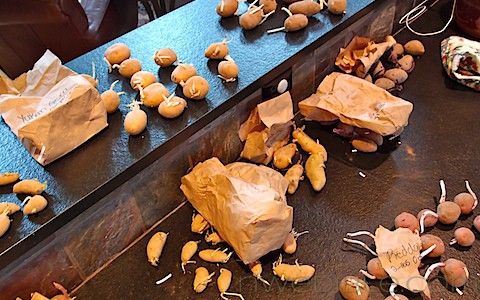
Some varieties were more eager to break dormancy and send out shoots than others.
Just like a seedling grown without enough light will get lanky and pale, so too will a potato shoot. (See the difference between a seedling grown with supplemental light and one grown without enough here.)
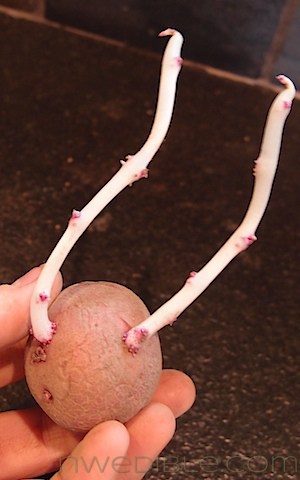
Maybe a good choice for stem culture, but these shoots will likely break when I cover them with soil.
Now, my goal had been to chit the potatoes, which is grower speak for encouraging the potato to send out shoots from the seed piece before planting.
But these anemic shoots were unlikely to survive transplanting. Many of them were thin and brittle enough that just a small bump would snap them or rend them from the seed piece.
The Problem With Weak Shoots
A seed potato is like your savings account when you are between jobs but still have bills to pay: only withdrawals, no deposits. Until the potato can get new leaf mass growing and establish a root system, all it has to live on is the energy stored in the seed potato. That energy allows the plant to send out these amazing shoots before it even has a root system.
But, by neglecting my taters, I allowed the seed piece to spend its valuable reserves on shoots that would, literally, never see the light of day.
It’s kind of like if, while on your no-job super frugal budget, you spend $50 on gas to get to a job interview only to realize your tank has a leak and within a day all the gas has dribbled out into your driveway. Not only have you lost $50 worth of gas, now you have to come up with another $50 so you can fill the tank again to get to that job interview.
And that’s the real problem with pale, weak shoots when you are chitting your potatoes. The potato spends energy to make them, but can’t benefit from them and so will have to spend yet more energy to make other, hardier shoots. It’s the opportunity cost.
Triaging Taters
To deal with the pale shoots of my potatoes I triaged the seed pieces. I removed the longest and weakest shoots from the seed potatoes. I set the unsprouted or only slightly-sprouted seed pieces aside on a counter where they’d be exposed to light. The potatoes with mid-range shoots I just exercised my judgement: if they looked sturdy enough to handle 3 inches of mulch dumped atop them, I left them.
As I was snapping off shoots that weren’t strong enough for reliable transplant, I told myself that by limiting the number of shoots on my seed potatoes I was potentially increasing the chance of larger potatoes at harvest time. Just like you can thin apples to encourage fewer but larger fruit, some of my research suggested you could thin potato shoots for larger tuber yield. I do not have personal experience with this, but if this crop of potatoes grow very large I’ll let you know.
Once you get over the psychological hardship of snapping a shoot off a seed potato, the act itself is very simple. Just rub your thumb over the shoot, or snap it back toward the potato. It will most likely come off cleanly. If I had an area with multiple buds, only one of which was overly long, I used scissors to snip that one off.
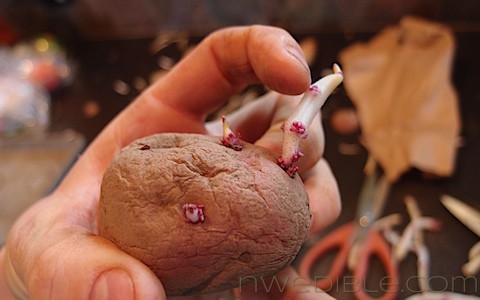
Snapping the longer shoot off but leaving the shorter buds. (Truthfully, this shoot probably would have transplanted just fine.)
After a few days in the light, the potatoes which were just starting to break dormancy were growing healthy, strong green-tinged shoots and those that had their overly-long shoots removed were looking fine too. A bit of energy was lost to the seed potatoes but otherwise everything should be okay.
It seems there are as many ways to grow potatoes as there are gardeners. How are you growing yours this year?
Blog title I really wish I had thought of: You’ve Got To Be Chitting Me
31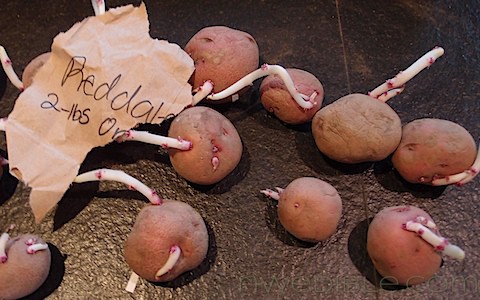
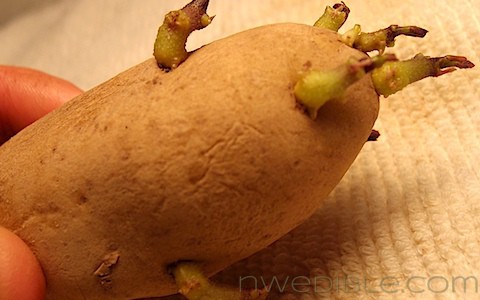
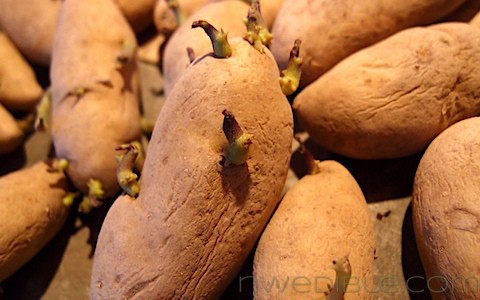
Thanks for this. Like I mentioned, I wasn’t sure what to do with my long-sprouted spuds. I still have bunches to plant (we were planning to succession plant them) so hopefully we’ll have some survivors!
Ruh roh. I did not chit my potatoes. They were a little eye-sprouty when I put them in their coffee sack homes this weekend. Like all things garden at my house, its an experiment. I figure only time is going to tell me if I’ve seriously screwed this up.
P.S. I think all my comments on Erica’s how-to garden posts begin with some form of “Oh, crap!”.
Not to worry – they’ll be fine. Chitting gives a head start, but potatoes are pretty bulletproof. The only thing I’d *never* advise is planting in burlap sacks. 😉 Actually, do let me know how your potatoes in sacks experiment works out – many people swear by that method.
HA! See, I am bound and determined to mess it up one way or another. 😉
I will admit, putting them into the sacks was a bit awkward with making sure there was enough soil and the movable sides and all.
Thanks Noelle for the 3-4 week time frame. Now I know when to keep my eye out for abject failure. 😉
It’s OK if you don’t chit. It will just take longer for the vines to come up. I didn’t do it last year (first year w/taters) and it took probably 3-4 weeks for the vines to emerge. Commercial potato farmers never chit because the sprouts break off in mechanical planters.
I made the same mistake – forgetting about them in the garage. I planted them anyways though and they are looking great so far. We’ve already had to pile on more straw and compost.
OK, for potatoes I’d like to make a pitch for growing at least some from true potato seed (TPS). You can get TPS (as well as some great tomatoes) from breeder Tom Wagner here: http://newworldcrops.com/wp/shop/
Advantages of growing TPS:
— It’s fun! You can grow some crazy potatoes not available commercially.
— You can grow your own virus-free seed tubers.
— You can create your own land race, adapted to your precise location and climate.
— You’ll be supporting potato biodiversity.
Disadvantages:
— Potatoes are outbreeders, so unlike tuber plants, TPS plants are not clones of the parents. You have to accept some diversity and cull accordingly.
— It takes longer to get a TPS plant up to full size than a tuber plant. The energy stored in the tuber gives those plants a huge head start over a seed-grown plant. It’s common to start them inside under lights because the plants are tiny and slow-growing at first.
— On a per-plant basis, the yield from a TPS plant is lower than a tuber plant. The idea is to create virus-free seed potatoes in the TPS year, then plant them the second year for much bigger yields.
I only chitted my potatoes for about a week, and it shows. About have of the sprouts have taken off, and the others are alive, but still very small. Oh well, maybe that will mean a staggered harvest?
I just save a bunch of the small potatoes from my fall harvest and they always end up with long pale shoots by the time I plant them out, but if I am delicate with them they do fine. They are a lovely creamy variety that my parents brought back from Germany in the 70’s so I don’t want to lose this stock.
I’m trying potatoes for the first time – planting them in narsty-looking orange buckets next to the driveway. I am trying to “disguise” the buckets so they aren’t such an eyesore. I just used commercial Yukons (I know, I know), but they are sprouting after two weeks. I’ll start filling them up a bit once they get taller.
I buy 50 lbs of potatoes every fall and whatever is left come March I plant in the garden. So they always have those long, pale chits. It’s never hurt anything that I can tell, just have to be careful with them.
In my experience, the largest potato yield came when I grew one seed potato in a 32 gallon trash can. I got 30 lbs of potatoes just from that one. I usually get around 40 lbs for 10 row-feet in the garden. So I was pretty astonished.
Can you give details as to how you grew mega-tater? I’d love to know what you filled the trash can with (garden soil, potting mix, etc.) and if and how you hilled up! That sounds great.
I used compost that I made and screened it so it was really fine and fluffy. I layered the compost with bone meal (sprinkled sparingly like pepper) in the trash can 3 feet deep (taking great care not to compact the soil). Then I placed my one little tuber in there and moved the can to the south side of my house under the eve. It gets really hot there in the summer!
As the potato vine grew I added more fine compost leaving no more than just a few new leaves exposed. I barely watered it, I wanted to soil to be on the dry side but not dry. When the vine finally reached the top of the can I stopped adding soil and let the vines grow. I also stopped watering. When the vines died I dumped the whole can out into the garden and unearthed my huge pile of tubers!! That was an unusually warm year for us.
Yes please, give details! I’m planning to grow them in 55 gallon barrels .. how many did you grow per tub, how much soil did you put down before planting and what did you use over the top of them? Any additional information would be wonderful!!! Thank you!
We’ve tried growing them in buckets, growing them in “towers” (layers of soil, compost , straw in a chicken wire cylinder), and we’ve tried mounding them. We weren’t very successful with any of those methods. This year we dug trenches and will add layers of soil and mulch as needed until we have eventually mounded them again. We’re hoping the extra 6 to 10 inches in that negative grade will help them to produce more.
Well we are trying something different …. we always seem to have issues with potatoes getting “bugs” so we are planting them in 55 gallon barrels, drilled with drain holes. I’m open to ideas if anyone has tried this before. Wish me luck! We’ll be using a comination of soil, compost, straw and manure but always open to suggestions!